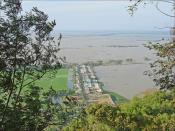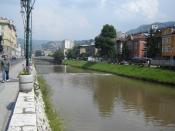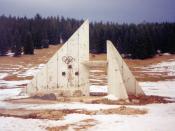The ride through the countryside was quite amazing. If you did not know, you would swear you were driving down a back road in Pennsylvania. The only visible difference were signs written in Cyrillic for little shops along the road. As the contours of Sarajevo came into focus, you could not miss the gaping, rubble-filled holes that were once buildings. I was not ready for the scenes of destruction that I was about to witness. I have hiked the hollow fields of Gettysburgh, read stories of the war in Vietnam, listened to stories from friends and colleagues that had served in Panama and Somalia, and watched the "100 Hour War" on CNN. Who really witnesses the effect and the price a city pays years after the bombs stop falling? As you walk around the once beautiful city, five years after the signing of the Dayton Peace Accords ended the war, the physical, damage cannot be ignored.
On April 5, 1992 Sarajevo, the capital of the Republic of Bosnia- Herzegovina, was attacked. The city lies in the valley of the Miljacka River and is surrounded by mountains. The 260 tanks and many other weapons placed on these mountains could destroy the city. On May 2, 1992 Serbs completely blockaded the city. The parts of the city that could not be occupied by the Serbs were exposed to a barrage of 2 shelling and artillery fire. Everyday the city was hit by some 4,000 shells. Targets included hospitals, schools, mosques, churches, synagogues, libraries, and museums.
As you cross the last crest coming into the city, the first image you see is the Unis Skyscrapers. These two skyscrapers are of equal height and were built to symbolize the brotherhood and unity of Sarajevo. Before the war, citizens called...


